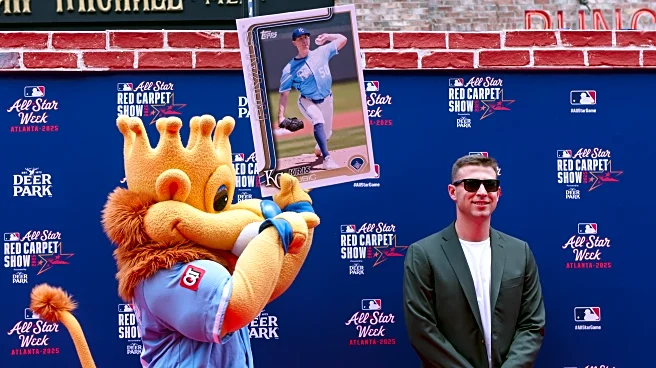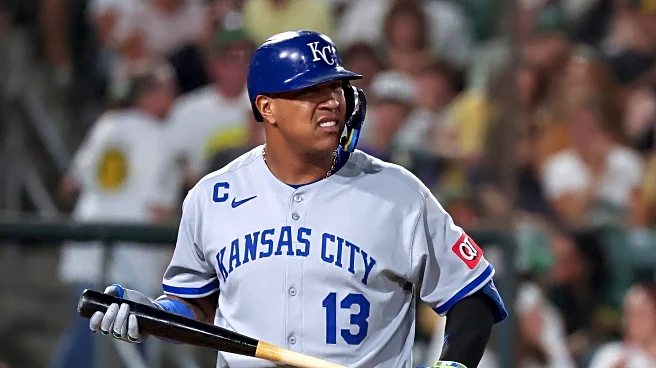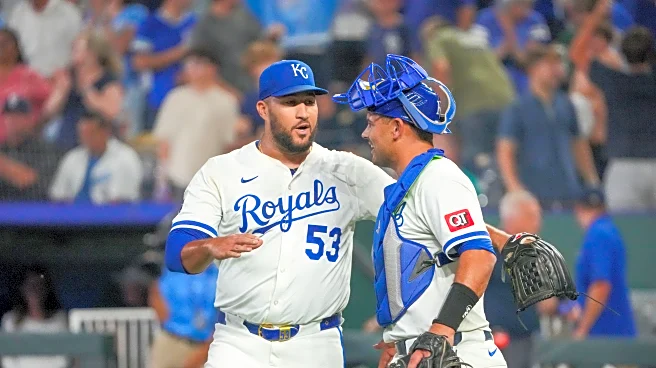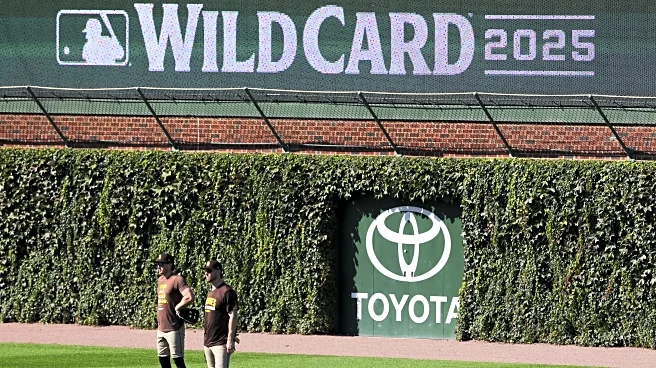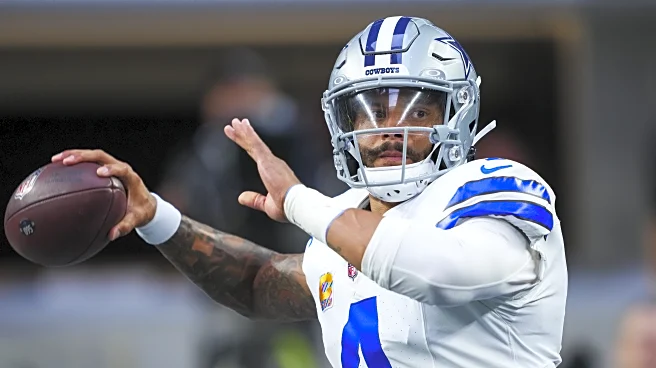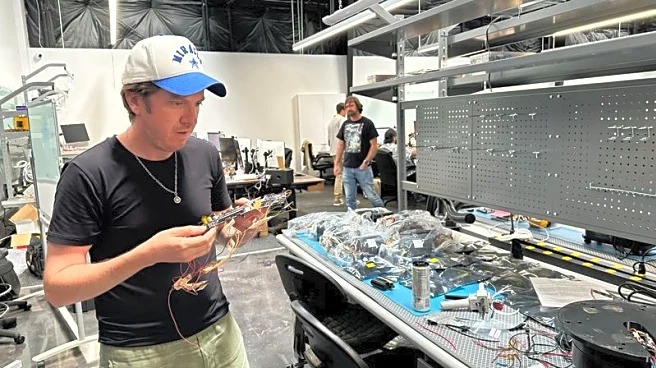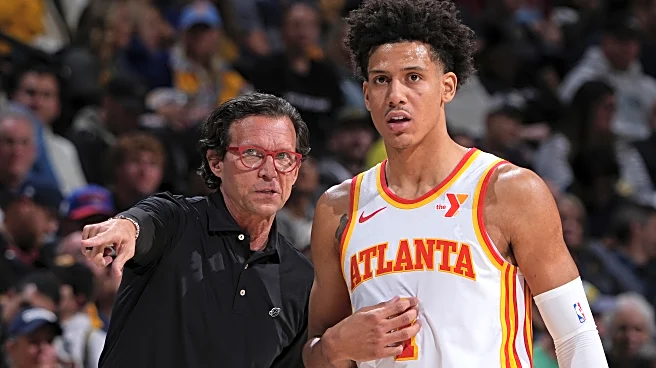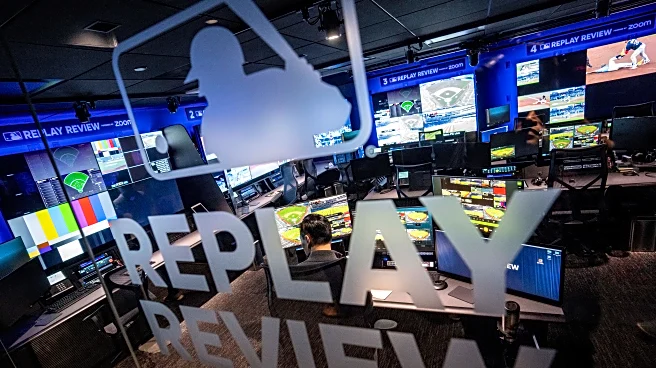At The Star, Jaylon Thompson wonders if the Royals pitching depth is how they hope to acquire offensive help:
“We saw how much Cole Ragans can change a game for us in the last three starts,” Picollo said. “I mean, it’s dominant type stuff. Kris Bubic, being an All-Star this year, it’s hard to ignore him and say he is fighting for a spot. But then, you get Noah Cameron, Ryan Bergert, Stephen Kolek and Luinder Avila to compete for that spot. So, there’s a lot of depth with how it works out at the end…”
“With depth, you are protecting yourself, number one, but then you also have assets that other teams are interested in,” Picollo said. “We don’t know if that is going to be the case or not. But if that’s the case, we know we have the depth to deal from our starting pitching. … So when you have a position of depth, it could be something you utilize to help in other areas.”
Pete Grathoff notes that five Royals from the 2021 pitching staff are in the postseason:
In a weird quirk, there are five members of the Royals’ 2021 pitching staff who made the playoffs this season. That 2021 season wasn’t particularly great as the Royals had a 74-88 record and finished fourth in the American League Central, 19 games behind the White Sox.
The Royals’ pitching staff had a 4.64 ERA that season, which was 19th in Major League Baseball. But five of those pitchers from that staff made the postseason this fall. Here is a closer look.
Can you guess them? I can’t do spoiler text so I’ll bury them somewhere in the movie reviews where no one is looking anyway
The Associated Press is doing year in review articles.
Kansas City continues to do well in the replay booth:
Big league teams improved their success in video reviews for the third straight year led by the Houston Astros, who were successful in 71.9% of their challenges. Houston won 23 of 32 challenges, Major League Baseball said. Milwaukee was next at 69.2%, followed by Philadelphia (66.7%), Arizona (66%) and Kansas City (65.6%).
Sure, it’s a giant jumbled table of numbers, but the Royals tied for the fewest pitch clock violations in baseball.
Blog Time!
The end-of-the-season meeting was a big topic. I mean, it was here with both Max and Jeremy writing about it.
Craig Brown also wrote about it at Into the Fountains.
As did Kevin O’Brien at The Royals Reporter.
And so did David Lesky ($) at Inside the Crown:
To be clear, I was one of those who believed they needed to make a change. But a switch almost flipped when the calendar turned to July. Maybe it was more of a dimmer switch because it didn’t happen all at once. But they scored six runs on July 1. They scored nine runs on July 4. They did that again on July 7. They hit .253/.312/.442 from July 1 through the All-Star Break, even though they still only scored 4.1 runs per game. But during the break, they acquired Adam Frazier. And after the break, they kind of went nuts. Culminating with a 12-1 win over the White Sox, the Royals scored 5.3 runs per game while hitting .254/.329/.447 over a 37-game period.
Things cooled off, as they always do. They scored 16 runs over the next seven games. Then they scored 11. Then they scored 11 over the next six games. But from September 13 to the end of the year, they scored 90 runs in 14 games with a .288/.349/.485 line. Sure, it included scoring 20 with 10 against a catcher, but even if you take out 10 runs, that’s 80 runs in 14 games. On the whole, they averaged 4.8 runs per game from July 1 to the end of the year. That wasn’t quite half the season, but it was close at 77 games.
Royals Data Dugout writes about their offseason plans. It also has a list of Royals blogs to keep up with during the offseason. Hint: most are ones we link to a lot, but if you want them in one place, this is a good resource.
Blog Roundup:
- Darin Watson at U.L.’s Toothpick: This Date In Royals History–1985 Edition: October 2 – Bud Black puts a forgettable season behind him with a crucial performance against the Angels, putting the Royals back in first place
- Oliver Vandervoort at KOK: 3 Royals players who should be shoo-ins for All-MLB team recognition
- Caleb Moody at KOK: Pair of former Royals relievers set to test free agent market this winter
I may have missed it, but I don’t think this has been mentioned here.
I got a request from MLB.com to change my password. That’s almost universally the sign that a company has just fessed up to being hacked (months ago) and CYA to minimize liability.
Sure enough, a quick internet search yields this story by Evan Drellich at The Athletic (probably $) from a couple of weeks ago:
Some Major League Baseball fans have arrived at ballparks this month to find their digital tickets have not only disappeared, but have been resold on popular platforms such as SeatGeek and StubHub.
In a statement acknowledging the problem to The Athletic, the league said that “bad actors” have been able to access fans’ tickets on a platform used by all 30 MLB teams — the Ballpark app — because of passwords scammers obtained or deciphered through other sources.
“The Ballpark app is operating properly and continues to process tickets for millions of fans who attend MLB games. There is no evidence that this was a breach of the MLB system,” the league said. “There have been widespread reports of significant data breaches on other platforms. Bad actors then have utilized leaked or stolen credentials from other websites in efforts to access the accounts of MLB fans.
In theory, this would mean that hackers are using passwords gained from other leaks to try and crack people’s MLB accounts. This is a common technique called a dictionary attack (it has its own Wikipedia page) and the best mitigation is to make sure your online accounts all have different passwords. That way if, say, there were a giant password breach of 16 billion credentials, a malicious actor couldn’t use your password stolen from Facebook to log into your MLB account. Hopefully that’s all it is and not a yet-undetected breach.
Not a ton of Royals content, so you don’t mind if I go long, right? I’m also falling a bit back on cliché – dumping a few more movie reviews. But it’s a busy time of year right now with school starting up and a big trip coming up at the end of the year that I’m still planning bits of. Good news for you: I’m out the next two weeks.
Actually, here, let’s run down the rest of the year for Friday Rumblings:
- 2025.10.10 OUT
- 2025.10.17 OUT
- 2025.10.24 TBD
- 2025.10.31 TBD – I need to come up with something Halloween themed
- 2025.11.07 Asia Baseball Recap: CPBL
- 2025.11.14 Asia Baseball Recap: KBO
- 2025.11.21 Asia Baseball Recap: NPB
- 2025.11.28 Black Friday OT/Asia Baseball extra week (if something else gets in the way of the first three weeks)
- 2025.12.05 2025 Second Half Recap
Trivia answer from above: Brad Keller, Jakob Junis, Scott Barlow, Brady Singer, Gabe Speier. I didn’t realize Barlow was still in the league – though it doesn’t surprise me as ground ball guy with good K rate ages well. I don’t think I could have named Gabe Speier if you had spotted me the initials “G S”.
We’re going to call today’s entry: “90s Movies and Sequels that Should Never Have Been Made (especially not 20 years later)”. We probably should have workshopped that into something more concise. Then again, these reviews are probably longer than any of these movies warrant.
* * * * *
A simple reading of Twister is that it’s a dumb disaster movie with questionable science, a nonsensical plot, and paper-thin characters. But I do think that undersells it. Yes, it plays (really) fast and loose with tornado science and physics. Like, I’m sure a belt around a pipe will save you from an F5 tornado. And it’s amazing how they keep chasing tornadoes with no deadly debris. And, really, who makes a scientific instrument that you have to leave in the path of a tornado?!?
But the characters are interesting enough for an action movie (especially when compared to the sequel). Helen Hunt (Jo) was in the middle of her Emmy streak, and this was a year before she won an Oscar for As Good as it Gets. Bill Paxton (Bill) was rarely critically acclaimed, though he had several notable roles in the 80s and 90s. Just a reminder about TV vs movie actors: I remember watching him in a half-season guest stint for Agents of S.H.I.E.L.D.; he was mostly phoning it in, yet he was acting circles around everyone in that show that wasn’t Clark Gregg or Ming-Na Wen. It would have been so easy to make the savant weather chaser burdened by personal trauma a man paired up with the settling-down, sensible woman, falling for a bad fit. But instead this works so much better. Additionally, you’re rooting against Cary Elwes, but you don’t despise him, so his death has an impact. The rest of the chasers are suitably quirky, as you’d expect: a young Phillip Seymour Hoffman, Alan Ruck and his silly maps, pre-Lost Jeremy Davies, etc. Even the little stop at Aunt Meg’s (Lois Smith) house is a nice little respite from the action sequences.
The action sequences are exciting and the effects look good for 1996. Heck, they still look good today. I swear many movies today look worse than the best effects of the 90s and early 00s. There are nice little bits like how the opening scene pays massive homages to The Wizard of Oz (though no self-respecting Midwesterner would be dumb enough to try and hold a storm cellar door down with their arms). The driving force behind the characters is to save lives, and it is believable. There appeared to be, at least, an attempt to put a small bit of cinematic veneer around an action movie. Oh, and the soundtrack is so very late 90s (including the last songs that Van Hagar made before Sammy was kicked out of Van Halen). So, yes, even though it’s clearly a breezy (hah!) action movie, there was some effort to make it slightly more.
I don’t think there is a word in English that captures just how low my expectations were for this movie. German probably has one. What’s a polysyllabic Deutsch word for “Low expectations resulting from a 20-year-old sequel that should never have been made”? TooManyNacthenJurassicWorldCrappengänger? I don’t recall any loose ends that needed tying up from the last movie. Neither did the creative team here. That’s ok – it didn’t matter as nothing is tying this to the original except the title.
With a better script, Daisy Edgar-Jones (Kate), Anthony Ramos (Javi), and Glen Powell (Tyler) are a good main trio. Powell owns practically all of the scenes he’s in. Though I could do without the “aw, shucks, you need to face your fears” message that should have been countered by Kate saying “anyone who didn’t have three friends die can kindly (expletive) off lecturing me about my trauma”. Edgar-Jones does her best with a meh script that’s a hazy echo of Helen Hunt’s character from the first. The role of Javi is mostly bunk – unrequited love turned lesser bad guy. None of the other characters are remotely interesting, save for Harry Hadden-Paton’s Ben, a British journalist following crazy Yankee storm chasers. Actually, I stand corrected: you despise the villains. Javi gets his funding from pre-Superman David Corenswet and his shady real-estate partner, who swoop in after the tornadoes and buy uninsured property for pennies on the dollar from people who just lost everything. Though you wonder how nice guy Javi ever got mixed up with these people and never left.
Many other superficial aspects of this movie mirror the first. The effects look similar. The rodeo tornado with no warning is laughable in this day and age. Maybe in 1997, there was limited warning, but technology is so much better now and EF4s don’t just spawn out of nowhere. They completely lack debris (again) and disregard a lot of physics (again) except when it’s plot-convenient (again). I can’t tell you if Kate’s “tornado killer” idea would work – I assume not or we’d already try it in real life – but we spend a lot of time telling the audience it will so it has to in the movie. This goes back to my “The Day After Tomorrow” theory of science fiction physics. If there’s a “scientist” spending time to treknobabble it onscreen, that’s how it works in that universe – but everything else works as it does in ours. That’s why, silly as they sound, “giant freezing category 6 hurricanes that come down from the atmosphere” work, but you can’t just have cold chase Dennis Quaid down a hallway – that’s not how things work and causes a suspension of disbelief.
If you can’t tell, so far, I feel like it’s just a pale imitation of the first. Heck, even the soundtrack is worse – trading rock and pop for mediocre country music. It’s weird – we’re used to studios nostalgia mining – and I fully expected tons of callbacks to the original. But we got very little of that, save the mentions of tornado instrument Dorothy. So why even attach the Twister name to it? Or even make the movie? It’s not really bad – it’s just not even there.
* * * * *
This movie is draped in awards, influential, and financially successful. Much better writers and scholars have espoused its praises, so I’m not going to waste too many words here.
Yes, it’s a slow burn of an epic, but Ridley Scott keeps it interesting. You could say the script is simple, but its singular, unflinching march through the plot is a strength, not a weakness. The movie made Russell Crowe a star, but Joaquin Phoenix also earned his Best Supporting Actor nod.
I hadn’t seen this movie in 20 years, but I’d like to point out a couple of little bits I noticed upon this rewatch. There’s a lot of proto Pirates of the Caribbean music here from Hans Zimmer, particularly in the second half of the movie. Also, this movie was the first I remember seeing the “herky jerky” action movie camera that would become prevalent for the next decade plus. It felt appropriate for a chaotic war or gladiatorial combat. However, I always lamented that, say, Daniel Craig’s James Bond or scores of other modern action movies opted for this style versus the action movie art of Crouching Tiger, Hidden Dragon or the Matrix trilogy.
What more can I say that hasn’t already been said? It’s well-directed and well-acted; it’s straightforward, yet compelling; it looks good and it sounds good. At worst, you can say it’s slow and is dark. But, ultimately, it’s a well-built movie, deserving of its praise.
When I told a friend of mine that we were going to watch Gladiator II, he mused that “the first 30 minutes are B reel from Gladiator followed by a Denzel movie”. He’s not wrong. If Gladiator had never been made, this would have been praised, though not to the level of the original. But as it’s a sequel, it’s mostly superfluous.
Paul Mescal (Lucius) is fine, but he’s not Russell Crowe. I guess making Lucias to be Maximus’s son ties it to the original, but his story isn’t as interesting. Pedro Pascal’s Acacius is a good “noble” foil to Lucius, and his marriage to Lucilla keeps this conflict all in the family. I love Pascal. Who doesn’t? But isn’t he getting overexposed these days? Similarly, Joseph Quinn and Fred Hechinger are also… fine, but, again, not Joaquin Phoenix. However, once Denzel Washington hits the screen, there’s not a lot of oxygen left for anyone else: “King Kong ain’t got sh*t on Macrinus”
Everything is just a little (or lot) less good than the original. The plot is more convoluted and contrived. Lucius’s story is far less compelling, but, in the end, this is as much Macrinus’s story as anyone’s. The fights and effects are still decent, though some of the CGI animals look bad – the monkey scene, in particular. On the whole, the movie is not bad. But when I was done, I couldn’t help but think that there was no reason for this movie to be made.
* * * * *
I also felt like Independence Day and Independence Day: Resurgence fall into this category. Though I wasn’t going to waste another 2 hours of my life watching Resurgence, so you get these lightly edited versions of reviews I wrote in 2018, which are a bit longer than the others.
I really wanted to give this film a 10. 16-year-old me gives this an 11. Yes, they use a Mac virus to defeat an alien armada. Yes, fire chases a dog down a hallway and stops conveniently when it ducks in a door (an Emmerich mistake he repeated with ice in a Day After Tomorrow). And, yes, it’s a popcorn action flick. But it’s the best earth-bound disaster movie ever made and will probably never be topped. Everything lines up across the board: directing, plot, characters, effects, dialogue, et al. In short, it’s really fun and little detracts from that experience.
Let’s start with the special effects because they were best-in-breed and still (mostly) hold up 20 years later. Computer technology has seen huge advances, but few effects in ID4 would really get better. Yes, some scenes could be improved, mainly bad green screening, like the helicopter escape from the White House or the aforementioned bad fire chase. But the real drama is created from seeing iconic buildings like the White House, The Empire State Building, and US Bank Tower (LA) blown to pieces. There’s the eerily serene scent with the alien ship hovering over NYC with the Statue of Liberty lying in the Hudson River. All of those were done with intricate models, and technology will do little to make those look better. The spaceships didn’t need any more technology to look better – they’re elegant in their simplicity. They’re a giant monolithic evil, nearly unstoppable, save for their Achilles’ heel.
Scaling is the thing that ID4 does better than any other movie. Roland Emmerich, Michael Bay, Marvel, and countless others have created dozens of disaster movies, and none have gotten it right like this one. From wiki: “Kenneth Turan of the Los Angeles Times felt that the film did an ‘excellent job conveying the boggling immensity of [the] extraterrestrial vehicles […] and panic in the streets’ and the scenes of the alien attack were ‘disturbing, unsettling and completely convincing’”. It’s a two-pronged assault on your senses: not only are the cities physically destroyed (the Michael Bay special), but you have enough character touchpoints to feel the destruction (we’ll get to those a little further on). Despite the huge scale and the ability for many parts of it to be lopsided, there are only a few rare moments that feel like missteps (for instance, the number of fighter ships feels like it ebbs and flows). In short, any list that doesn’t have it at or near the top of its disaster movie list merits scrutiny or outright dismissal.
It’s not breaking new ground to say that action movie acting is not the same as drama acting. But the action movie formula is maximized. Will Smith is at the peak of his audience-drawing power: in the middle of his music career, post Fresh Prince, and sandwiched between Bad Boys (1995) and Men in Black (1997). Jeff Goldblum was still fresh (pun not intended) in people’s minds as the archetype-creating rock star scientist Ian Malcolm from Jurassic Park (1993). They are the perfect odd couple. One, Captain Steven Hiller, is a decorated Air Force pilot who wants to be an astronaut but can’t because of the woman he loves. The other, scientist David Levinson, is an MIT grad who found the rat race unfulfilling, so he works in the cable television business and tries to save the world in small ways like recycling. They fight aliens.
But to paint this as just a buddy pic shorts the rest of the ensemble cast. The second billing (pun only slightly intended) goes to one of the Bill P’s, Pullman, in this case, as idealized Bill Clinton – young and intelligent, but a family man with military service. His rousing speech is iconic, though, yes, we’ll get to the 90s cultural implications in a minute.
All three of the main characters have romantic interests – this could be viewed as antiquated sexism, but each also serves a “literary” purpose as well. Hiller is dating an adult dancer, Vivica A. Fox’s Jasmine Dubrow. She’s not portrayed as salacious, but as street-smart and used to illustrate the struggle of “normal” people after the invasion. She’s also used to explain why he’s not an astronaut and to show that he has a heart of gold. First Lady Marilyn, played by Mary McDonnell, reflects many of President Whitmore’s better qualities. But she also helps show how this disaster affected all, from the most vulnerable to the most powerful, and her death adds emotional heft to the disaster, making it personal for the audience. Finally, Margaret Colin’s Constance Spano is part of the 90s time capsule of the movie: Levinson is considered immature because he didn’t have traditional ambitions and wanted a family, while she is portrayed as the modern career woman, and the pitfalls of that choice.
Even once we get past those characters, we’ve left out some major players. Randy Quaid’s Russell Casse gives us knowledge about the aliens that seems perfectly natural coming from his character, who is just a bit broken but trying to keep his family together. I appreciated that the initial plot had him using his crop duster to destroy the alien ship after he was denied a fighter jet for being too drunk. It tied a little more nicely to the character’s previous backstory. However, they weren’t a slave to it, and the sacrifice that made it into the final cut worked better for that moment. It was some of the perfect “action movie” direction of the movie – he looks at his kid’s picture, the scene pans to the kids, we see the regret in Quaid’s face, but then we see everyone else who could be saved, and he makes the ultimate sacrifice.
Judd Hirsch is a walking stereotype (hey, it’s the 90s!), but lends both levity and gravity to various situations as well as a light spiritual side in the praying scene. Harry Connick Jr and Harvey Fierstein also have memorable moments balancing light and dark. Robert Loggia’s General Grey, Adam Baldwin’s Major Mitchell, and Dan Lauria’s (the dad from The Wonder Years) “Commanding Officer – all provide proper recognizable straight men as part of the military apparatus. Brent Spiner’s Dr. Okun is still his second biggest role on his Wikipedia page after his iconic Data from Star Trek and is a memorably quirky role. Finally, James Rebhorn plays Albert Nimzicki, the sniveling Secretary of Defense and a foil for all the “heroes”. Apparently, his names and mannerisms are based on an executive at MGM who, per wiki, “made life unpleasant for Devlin and Emmerich when studio executives forced recuts of Stargate”.
The movie structure isn’t perfect. For instance, Hiller finding his girlfriend and the First Lady in the middle of nowhere was completely unbelievable. But, I think at some point, they just said “we’re going to have to force something here” and that was the moment to bring your characters back together. However, other than Levinson’s ex being in the White House, giving him access to the remaining security apparatus, none of the connections were necessary for the plot to happen.
That the President was a fighter pilot would have been contrived if he had been the one to shoot down the alien ship. But his missile fails. We’re following Hiller’s and Casse’s story precisely because they are the pair who take out the mothership and the first attack ship. But nothing in their background made them exceptional characters who were the only ones who could save the day. It’s egalitarianism, not elitism, on display.
I don’t think the directing in this movie is appreciated nearly enough. It’s a perfectly staged disaster film and each of the 3 acts even has on-screen cue cards. As illustrated above, one of the other underrated aspects of the movie is how it weaves just the right number of threads. The audience feels the complexity of the situation and a range of emotions, while not making the movie too complicated for a summer blockbuster crowd.
Some great light touches enrich the world-building but also function either as humor or exposition. For instance, in a completely unremarkable scene, as they’re driving to the White House, Levinson’s dad is chastising him for spending “eight years at MIT to become a cable repair man”. In those 30 seconds, we understand the father-son dynamic, establish David’s bona fides, and the setting around them shows the panic in the streets as they are the only ones driving into Washington DC while everyone else is trying to get out. This economy of screen time makes for a pretty dense movie. It clocks in at 2:25 in length but has a lot of stories to tell in that time. There are also a number of other time capsule moments like an X-Files joke, a McLaughlin Group clip, and REM’s “It’s the End of the World as We Know It (And I Feel Fine)” – though the last one is a little on the nose.
David Arnold’s score is excellent. Amusingly, from wiki: “The Grammy Award-winning score for the film was composed by David Arnold and recorded with an orchestra of 90, a choir of 46, ‘and every last ounce of stereotypical Americana he could muster for the occasion’… the film’s producer Dean Devlin commented that ‘you can leave it up to a Brit to write some of the most rousing and patriotic music in the history of American cinema.’” Like so many aspects of the movie, it’s tempting to label it as “tired”. However, this is the often imitated movie many of these conventions and clichés come from. It’s not old hat if you’re the first one.
One of the questions I’ve posed: “Is this the most American movie ever”? We see this theme at work in 1999’s (so, almost, but not quite, a contemporary) The Matrix, too, as Agent Smith says it was designed after “the peak of your civilization”. There’s the conflicting message of everyone working together, but led by American paternalism. It’s an idealistic one, but then again, when has imperialism not been? Oh, and the President’s speech doesn’t really play well anywhere else. Per wiki, BBC’s review refers to it as “the most jaw-droppingly pompous soliloquy ever delivered in a mainstream Hollywood movie.” Guilty.
Put it all together and you have a blockbuster that was very popular at the time and still widely enjoyed. When released, it raced to the second highest worldwide grossing movie and helped reinvent disaster movies as summer tentpoles (Armageddon/Deep Impact, every Emmerich movie since). I think many aspects of it are underappreciated as critics’ grading scale seems skewed toward particular types of movies. But this movie does what it sets out to do in revolutionary ways and ruthless efficiency and that should be appreciated.
Independence Day: Resurgence (2016)
With how much I love the original and poor reviews of the sequel, I had pretty low expectations coming in. This mostly met them, and my initial instincts of “this movie never should have been made” were correct.
Like the first movie, this has 3 distinct acts. The first is actually pretty good: we have an alternate future of the world rebuilding with alien technology after the events of 20 years ago. Earth is planning for the 20th anniversary of the invasion, and we check in on all the main characters from the first movie. Will Smith’s character is survived by his stripper-turned-doctor wife (Vivica A. Fox) and son Dylan Hiller (Jesse Usher). President Whitmore (Bill Pullman) is going mad from his exposure to the aliens while his daughter Patricia (Maika Monroe) works in the White House, writing speeches for President Lanford (Sela Ward). Julius Levinson (Judd Hirch) is estranged (oddly forced) from his son, David Levinson (Jeff Goldblum), who is still studying the aliens. We find him in Africa with a quasi-love interest, Dr. Marceaux (Charlotte Gainsbourg) and an African warlord, Dikembe Umbutu (Deobia Oparei) whose people fought Earth’s only ground war against the aliens. So far, so good. Most of our characters are where you’d expect them to be and the African plot actually adds a little depth.
Still, we start out on some shaky ground. Patricia is engaged to well-meaning meathead Jake Morrison, played by one of the lesser Hemsworths (Liam, of Hunger Games fame). He has a useless buddy, Charlie Miller (Travis Tope), who really doesn’t need to be in the movie as he just serves to add flight buddy clichés and to pine after the token superfluous character, Rain Lao (Angelababy). You don’t buy that Hemsworth lost his parents and Hemsworth and Usher’s little conflict seems totally manufactured. Almost all of the emotional links require at least one partner who is in their 20s and none of them sell it enough for you to buy it. The most emotional scene in the movie is a tender moment between Dr. Okun (Brent Spiner) and Dr. Isaacs (John Storey) and that even upset people (long story).
There’s no cathartic release of Will Smith punching an alien, no Jeff Goldblum anger and despair from wiping out Houston with nukes, no tragedy of losing the first lady and Bill Pullman having to explain that to his daughter, no stirring speech from the President, and no elation and relief from victory. The emotional heft of the movie is more Starship Troopers than Independence Day. Think about that: I just said disaster movie ID4 had a lot more emotional heft.
Yes, there was no way the movie would be able to exceed the scale of the original. However, in the disaster movie department, it isn’t even that good, effect-wise. It looks more Michael Bay than Roland Emmerich. It’s all CGI and done on such a grand scale that you never really feel it. There are a couple of throwaway scenes of random car drivers right before they are crushed. But in ID4, it’s the exotic dancer (Kiersten Warren) who gets a couple of minutes screen time with Fox or the First Lady who feels the impact. Additionally, the carnage feels more visceral when it’s the model of an iconic building versus a few bits and bytes.
This movie was going to be a tough needle to thread in the best of circumstances. It was going to be more science fiction than disaster movie due to its alternate timeline. But the movie makes so many missteps that it’s far from the best case scenario. The idea of the original Independence Day is so simple you can explain it in a couple sentences: Aliens with giant spaceships and force fields try to take over earth and destroy major cities with space laser; Ian Malcolm gives them computer virus and Fresh Prince delivers giant nuke to destroy the mothership. If I had another sentence, it’d be something about President Bill Pullman’s stirring speech and drunk Randy Quaid (redundant?) sacrificing himself to save his children and the world.
This one just has too many pointless plots and characters. In act 2, the alien queen sets a trap… but to what end? The aliens have technological superiority, and the humans already couldn’t beat them. Usually, the trap is to steal the last MacGuffin the bad guy needs, like, say, the fusion nukes their bombers were carrying. Instead, it serves no purpose and, of course, is instrumental in the good guys defeating them from the inside. Similarly, the third act has a bunch of unnecessary time bombs: the aliens are trying to destroy Earth’s core, the giant spaceship is trying to destroy the humans, and the aliens want some mystic orb the humans have. If you’re the aliens, just work on destroying the core and the first two goals are solved. However, you need to decide if you want to destroy the core or get the orb because if you destroy the earth, you’re not getting a core. It’s redundant convolution. Similarly, there are too many characters to focus on – as mentioned before, Hemsworth’s flyboy buddy is needless, as is his “love interest”. Similarly, there’s some bureau guy who learns to kill aliens from the African warlord. There’s just a lot of vestigial mess that needed to be cleaned up so more focus could go to the important aspects of the movie. Instead, it’s spread way too thin and very underdeveloped. There’s even a bad version of Bill Pullman’s speech given by a lesser actor.
They made a real attempt to pay homage to the original. Only director Roland Emmerich and producer Dean Devlin (both on the screenplay credits, too) forgot to bring something new. It’s a cautionary tale on the Marvel model – not everything can be the first in a new trilogy. If your first entry is too weak and doesn’t make enough money, there are no second and third movies. That said, sure, some of the sins are in building future plots (the orb, extra characters?), but a lot of those were unforced errors that can’t be blamed on that problem. I really wanted to like it, and the first act gave me hope that it was better than expected. Unfortunately, Act 2 was bad and Act 3 was worse.
Let’s used that aforementioned David Arnold score. The End Titles track mashes together most of the notable themes from the movie:
